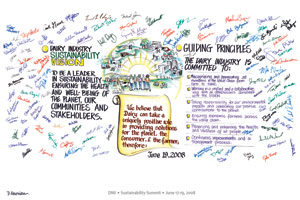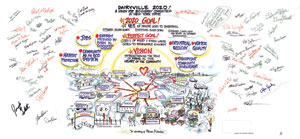Early this year the Innovation Center for U.S. Dairy released its first-ever Sustainability Progress Report. Progressive Dairyman interviewed Erin Fitzgerald (pictured below left), the center’s vice president of sustainability, to review some of the highlights of the report. Below are her comments about excerpts from the report. Click here to view the image at right full-size in a new window. Q. How did this sustainability effort get started? In 2008 we brought together 200 stakeholders including NGOs, academics, producers, retailers from across the dairy value chain and asked them how we could reduce greenhouse gas emissions and produce value.
What came out of that was a clear vision for our sustainability commitment as well as 10 projects that are worth conservatively $238 million and a 10% reduction in our overall greenhouse gas footprint.
Q. Why do a report like this?
 “The goal of this report is to serve as a resource to stakeholders who are increasingly asking qualitatively and quantitatively what the dairy industry is doing toward sustainability.”
“The goal of this report is to serve as a resource to stakeholders who are increasingly asking qualitatively and quantitatively what the dairy industry is doing toward sustainability.”
Q. Who are these stakeholders you mention?
Consumers, environmental organizations, government, milk buyers, co-ops.
Q. What’s an example of a quantitative piece of sustainability included in the report?
We contribute to 70 percent of the nation’s calcium needs. Our carbon footprint is approximately 2% of greenhouse gas emissions. Qualitatively we have some amazing stories in the dairy industry, but the work of this initiative will be to back those up with science.
Q. Should dairy producers be alarmed or encouraged by this report’s findings on their portion of the value chain emissions (51 percent)?
Most life-cycle assessments will show environmental impact at the source of where raw materials are made or are interacting with land, air and water. What they should feel proud of is that the industry is supporting and aligning around the producer. We all deliver the final product to our consumer. We are in this together.
Q. Why would you encourage a dairy producer to review a copy of the report?
A dairy producer should be incredibly proud of their industry’s willingness to be a leader in sustainability. I think this report and its framework give producers the right language to express their story of stewardship to their neighbors and communities.
Q. What should producers be proud of in this report?
We were able to quantify our environmental impact. The top highlight is the publication of the life- cycle assessment. This report really does quantify where environmental impact occurs along the value chain.
Q. What parts of this report would you like to improve?
We know the scope of what we are trying to do is immense. We already have 500 stakeholders contributing approximately 14,000 man-hour days of time. It is our goal to continue to build the resources required to support the industry’s sustainability efforts. Last year we raised $1.6 million of investment. We need more people to bring the best of the best to solve problems and capture sustainability’s opportunities.
Q. How will this report help the industry market more milk?
Increasingly, consumers are asking these questions. There is an upward increase trend in corporate social responsibility reporting. Consumers in this digital age want to see transparency. They want information and fact. We hope this report will serve as a guide for brands and co-ops to point those consumers to solid resources.
Q. What is Dairyville 2020?
This picture was one of our projects called Dairy Power. We hosted a summit in New York in 2009 and asked how we could process 40 percent of manure into digesters and what would be the social, environmental and community benefit of doing so. This is representative of looking at a dairy farm as part of a community solution.
Click here to view the image at full size in a new window.
Q. How are producers getting involved?
Producers noted in the sustainability progress report are providing leadership and helping to drive innovation by participating on the Sustainability Council, Innovation Center board of directors and the Common Voice team.
Many more producers participate in the sustainability commitment through volunteering their time to work on the 10 GHG reduction projects, telling the stories of their own efforts to reduce environmental impact, and providing data for life-cycle assessments and other research. PD
Access the report online at: www.usdairy.com/sustainability/
Dairies, producers and co-ops named in the report:
Anderson Erickson Dairy
Besancon Farms/Brent Besancon
Byrne Dairy
California Dairies Inc
C Bar M Dairy/Greg Ledbetter
Clauss Dairy Farms
Emerald Dairy/John Vrieze
Fair Oaks Farms/Mike McCloskey
Fiscalini Farms & Cheese/John Fiscalini
Foremost Farms USA
Foster Brothers Farm
Gar-Lin Dairy Farm/Dana Allen
Graywood Farm
Green Meadow Farms
Haubenschild Farms/Dennis Haubenschild
HAR-GO Farms/John Goud
Holsum Dairy/Ken Beulow
Land O’Lakes
McArthur Farms Inc/Robert Rydzewski
Nobis Dairy Farms
Otsquago View Farms/Craig Stevens
Paul Rovey Dairy/Paul Rovey
Prairie Farms Dairy
Prairieland Dairy/Dan Rice
Rice Dairy/Peter Turk
River-View Farm/Dave Forgey
Select Milk Producers
Shamrock Farms
Spruce Haven Farm
Stonyfield Farm
Stouder Holsteins/Bill Stouder
Swiss Valley Farms
Twin Birch Dairy/Dirk Young
Wanner Farm/Alfred Wanner





